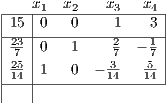
- a.
- Derive a Gomory cutting plane from each constraint and verify that it is violated by the solution to the current LP relaxation.
- b.
- Add the Gomory cut corresponding to the second constraint and reoptimize. What do you conclude?
Math Models of Operations Research
MATP 4700
Homework 6
Due: Tuesday November 21 11.59pm, on LMS.
25% penalty for each day late
Questions from Kupferschmid, Chapter 7 (available on LMS):

In addition, read Sections 7.1–7.7 from the text.
Solving the homework problems (and other problems from the text) will improve your understanding of the material.
Working out the problems yourself will greatly improve your understanding of the material and help you on the exams.
You can ask questions on piazza, in addition to using office hours or email.
| John Mitchell, mitchj at rpi dot edu |
| Amos Eaton 325. x6915. |
| Office hours: |
| Tuesdays 2.30–4pm in AE 325; |
| Thursdays 1–3pm webex: https://rensselaer.webex.com/meet/mitchj |
| TA: Marguerite Demasi, demasm at rpi dot edu |
| Office hours: Mondays 2–3.30pm in AE 317. |